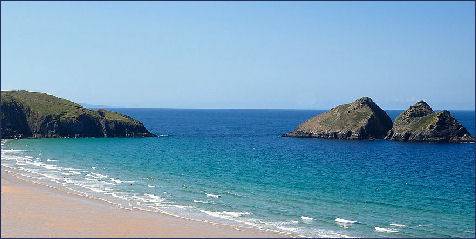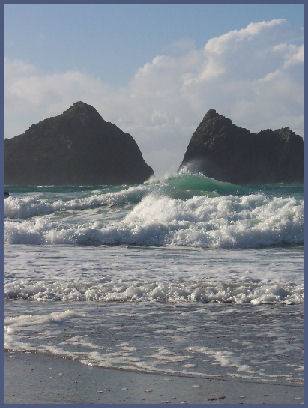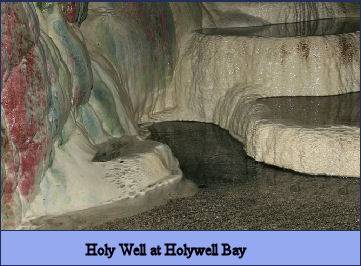Holywell
OS Grid ref:- SW765595
 Holywell Bay is situated to the south of the seaside resort of Newquay on Cornwall's Atlantic Coast.
Holywell Bay is situated to the south of the seaside resort of Newquay on Cornwall's Atlantic Coast.
Known in Cornish as Tregew, the bay is sheltered below the slopes of Penhale Point and makes a popular holiday resort destination.
The large, clean and safe beach which is surrounded by cliffs, is protected by the National Trust and is nearly a mile in length, it is a holder of the Marine Conservation Society Good Beach Guide Award and was Recommended in 2014, the water quality at Holywell being described as excellent. RNLI Lifeguards operate throughout the summer from May to September.
Holywell Bay is exposed to large Atlantic swells and is a popular spot with surfers, there is a surf school on the beach and equipment can be hired locally. The huge beach is backed by grass covered sand dunes, which are over 5, 000 years old and are the tallest in Britain. A stream runs through to the sea and there are caves nearby to explore.
 Dolphins can sometimes be sighted off Gull Rocks, the two distinctive pyramid shaped rocks which protrude into Holywell Bay are the bay's most prominent feature. They are also sometimes known as Carter's Rocks. A sea cave is located at the northern end of the beach with rocks bearing vivid-coloured calcium deposits, some of which are blood-red in appearance, which can only be accessed at low waters.
Dolphins can sometimes be sighted off Gull Rocks, the two distinctive pyramid shaped rocks which protrude into Holywell Bay are the bay's most prominent feature. They are also sometimes known as Carter's Rocks. A sea cave is located at the northern end of the beach with rocks bearing vivid-coloured calcium deposits, some of which are blood-red in appearance, which can only be accessed at low waters.
At the southern end of Holywell Bay beach lies a ship wreck which can be sighted at low tide, the SS. Francia. The Francia was an Argentinean ship carrying a cargo of coal, it was wrecked in 1917, when it hit the shore it broke its back and was stranded, a fair amount of the ship was salvaged but the rest had to be left behind and it has remained there ever since.
Holywell Bay Leisure Park, situated close to the beach, offers entertainment for children, the park also features an ice-cream parlour, high-quality diner and bar / restaurant. Entry and parking are free. Holywell Golf Course is an 18 hole all challenging par 3 course.
Holywell village has a few shops and two pubs, the Treguth Inn, a characterful thatched inn and former farmhouse dating from the thirteenth century which serves meals and St Pirans Inn, which is situated closer to the beach and also serves food. 1 ½ miles away at the village of Cubert there is a Post Office, restaurant and two more pubs.
Directions
Holywell Bay is situated about 16 miles from Truro and 6 miles from Newquay. Proceed on the A30 from the east or west. At the Boxheater junction turn north onto the B3285 which is the road to Goonhavern. (signposted to Perranporth and Goonhavern). Continue on this road and at Goonhavern turn right onto the A3075. About 2 miles later turn left onto the road for Cubert and Holywell (signposted to Holywell Bay). Follow this road through Cubert to Holywell village.
The Holy Wells of Holywell Bay
Holywell Cave
 There are two famous holy wells at Holywell Bay , lying a mile apart, from which its name is derived.
There are two famous holy wells at Holywell Bay , lying a mile apart, from which its name is derived.
The first well is in a two hundred feet high cave at the northern end of Holywell Bay, it can be accessed only at low tide. Water seeps from the multi-coloured rock and mothers formerly crossed the sands of Holywell Bay to immerse their ailing children in the healing water.
This must be the most curious location for a Holy Well, and displays no obvious Christianisation. The well was so famous that it gave its name to the whole bay. Narrow lane from Cubert leads down to Holywell Bay where there is limited parking.
Approach the cave with caution at low tide and watch out for signs of the tide turning.
Trevornick Holy Well
OS grid refence- SW773588
The second well lies to the east of Holywell, on the golf course at Holywell Bay and is located next to the Trevornick Holiday Park, which is off the only road from the village of Cubert to Holywell Bay.
An evocative site, the water from the well bubbles out from the rock and into its basin and from there it overflows through a lipped channel to descend the hill and empty into the sea at the wide expanse of Holywell Bay. The Trevornick well is considered by some authorities to be the authentic holy well of St. Cubert.
St. Cubert was a Welsh missionary who, as a companion of St Carantoc, brought the Christian faith to this part of Cornwall. Unlike his companion St Carantoc, who travelled on to Brittany, St Cubert returned to Wales becoming abbot of his monastery and, according to the Welsh chronicles, died in 775.
The Newquay Old Cornwall Society restored the stone structure around a natural spring, and there is an inner and outer Gothic arch to mark the site.
The well may be accessed from the beach and across the golf club, or by following the public footpath that crosses Trevornick Holiday Park.